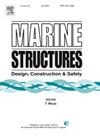An integrated hydrodynamic module of FOWTs using accelerated BEM solver and modified Morison coefficients
IF 5.1
2区 工程技术
Q1 ENGINEERING, CIVIL
引用次数: 0
Abstract
Hydrodynamics is critical to the stability and safety of floating offshore wind turbines (FOWTs). To improve computational efficiency in the preliminary design stage, frequency-to-time domain potential flow method combined with the Morison equation are commonly used. However, this method lack systematic validation and require multiple tools, leading to complex workflows and inefficient data transfer. To address these challenges, an integrated hydrodynamic module named Zwave is presented in this study, aiming to streamline wave generation, meshing, potential flow analysis, and viscous force calculation. It incorporates advanced features such as parameterized meshing, an accelerated boundary element solver, and amplitude- and frequency-dependent Morison coefficients. Component-level verification shows that Zwave accurately reproduces target wave spectra, and its hydrodynamic results align well with WAMIT in the frequency domain and Orcaflex in the time domain. Furthermore, with corrected Morison coefficients, Zwave successfully captures the resonance responses observed in wave basin tests. Building upon this, system-level validation is performed using field measurements from the Fukushima 2 MW FOWT, demonstrating good agreement in tower base and top bending moments under various sea states.
利用加速边界元求解器和修正的莫里森系数,建立了一种集成的流体力学模型
流体力学对浮式海上风力发电机的稳定性和安全性至关重要。为了提高初始设计阶段的计算效率,通常采用结合Morison方程的频域-时域势流法。然而,这种方法缺乏系统的验证,需要多种工具,导致工作流程复杂,数据传输效率低下。为了解决这些挑战,本研究提出了一个名为Zwave的集成流体动力学模块,旨在简化波浪生成,网格划分,势流分析和粘性力计算。它结合了先进的功能,如参数化网格,加速边界元求解器,以及依赖于振幅和频率的莫里森系数。分量级验证表明,Zwave能准确再现目标波谱,其水动力结果与WAMIT在频域和Orcaflex在时域上吻合较好。此外,通过校正Morison系数,Zwave成功捕获了波盆试验中观测到的共振响应。在此基础上,利用福岛2mw FOWT的现场测量进行了系统级验证,证明了在各种海况下塔底和顶部弯矩的良好一致性。
本文章由计算机程序翻译,如有差异,请以英文原文为准。
求助全文
约1分钟内获得全文
求助全文
来源期刊

Marine Structures
工程技术-工程:海洋
CiteScore
8.70
自引率
7.70%
发文量
157
审稿时长
6.4 months
期刊介绍:
This journal aims to provide a medium for presentation and discussion of the latest developments in research, design, fabrication and in-service experience relating to marine structures, i.e., all structures of steel, concrete, light alloy or composite construction having an interface with the sea, including ships, fixed and mobile offshore platforms, submarine and submersibles, pipelines, subsea systems for shallow and deep ocean operations and coastal structures such as piers.
 求助内容:
求助内容: 应助结果提醒方式:
应助结果提醒方式:


